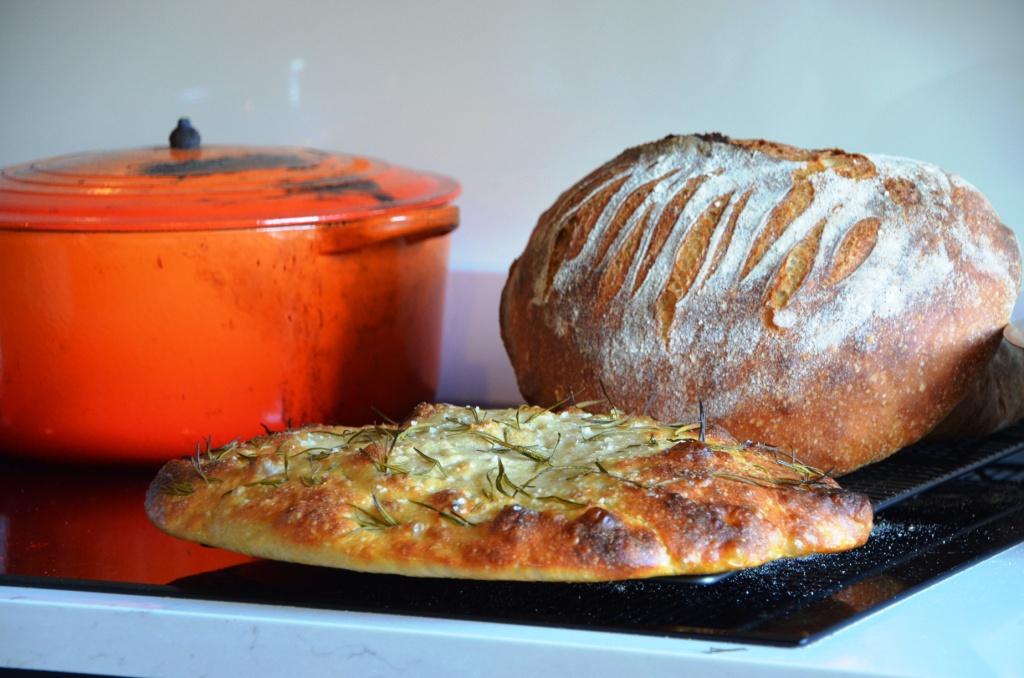
Sometimes in life you need to slow down, stop rushing and take your time. If you’ve ever wanted to make sourdough, then taking things at a slower pace is essential. This king of loaves can’t be rushed. To do it properly, you need to start several days ahead if you want a crusty warm slice or two for your Sunday tea.
Online instructions for home-bakers can be conflicting, so when Laura Scott from How to Cook Good Food invited Local Food Britain to join in one of her sourdough demonstrations, we jumped at the chance to discover the mysteries behind this holy grail of breads. Add to that the thought of once again spending an enjoyable morning with this softly spoken and passionate chef in her beautiful Epsom home, and the date was very quickly circled in the LFB diary.
And so, one Saturday, we joined three other sourdough newbies on high stools around Laura’s kitchen work table. Over coffee and a slice of her home-made butterscotch blondies (who could resist?!), Laura explained that sourdough is like no other bread.
To physically demonstrate the making of sourdough in real time, Laura would need to offer a B&B service and invite her pupils to sleepover for a few nights. So instead, in true Blue Peter style, she had prepared the dough at various stages of its life so we could see what those looked like.
Simple ingredients plus time
While the making of sourdough needs careful explanation, its ingredients couldn’t be simpler. It is made with just three – water, salt and flour – and it all starts with a starter, not yeast like other breads.
This starter is made with water and flour and carefully `fed’ over several days, with more water and flour. Kept at room temperature, it will begin to ferment. We learnt that sourdough aficionados claim that every starter is different, holding within its bubbly structure the characteristics of that person’s home and environment,which is defined by the local water and air around it.
To get to the dough stage, more water and flour is added in greater quantities, plus salt.
If you are a keen gardener or DIYer, then plan a project to do in between kneading the dough, says Laura, as this process again takes several hours. The kneading itself is quick, with gentle pulling and slapping motions rather than the workout required for an ordinary dough. But in between kneading, the dough must rest for half hour intervals for up to two to three hours. And after that it requires an overnight snooze in the fridge before you even begin to shape it into a loaf.
“Here’s one I prepared earlier,” repeats Laura, bringing out a prepared and well-rested dough and we were ready to watch her shape it into two beautiful round loaves. Leftover dough was then deftly turned into a giant tray of rosemary and sea salt focaccia.
With the loaves and the focaccia now baking in the oven ready for lunch, it was our turn to take some of Laura’s starter and make our own little jars of `sourdough promise’. This was easily done with a large spoon of Laura’s starter, and yes, you’ve guessed it, more flour and water. How comforting to think that every time we made our own loaves in the future, they would carry the memory of our mini master class!
A delicious lunch
All the talk of not rushing and taking time had as soothing an effect on Laura’s `students’ as it did the sourdough. By the time lunch arrived, the stresses of the week had disappeared and we were happy to simply tuck into the cheeses artfully arranged amongst olives, fresh figs, baby tomatoes on the vine and grapes, and savour the piquant spicy pumpkin and ginger soup (recipe please Laura!).
Gentle banter mainly centred on food and which of the cheeses was our favourite. Of course, the fresh chunks of sourdough and focaccia were the stars, and proved there is no truer saying than good things come to those that wait.
Epilogue: Nearly a week later, and after much nursing of the starter, Local Food Britain finally produced a sourdough rosemary and sea salt focaccia. It wasn’t quite like Laura Scott’s six-centimetre-high wedges of heaven, but the sense of achievement was enormous.
- For more information and to book How To Cook Good Food’s `sourdough pop-up bread demo and lunch’ e-mail Laura on Lauracooksetc@gmail.com.
Tags: bread

